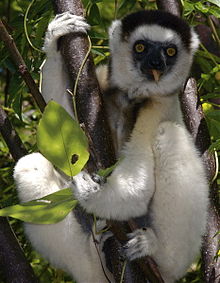Propithecus verreaux grandidier
| Verreaux's sifaka | |
|---|---|
 |
|
| Scientific classification | |
| Kingdom: | Animalia |
| Phylum: | Chordata |
| Class: | Mammalia |
| Order: | Primates |
| Suborder: | Strepsirrhini |
| Family: | Indriidae |
| Genus: | Propithecus |
| Species: | P. verreauxi |
| Binomial name | |
|
Propithecus verreauxi A. Grandidier, 1867 |
|
 |
|
| Distribution of P. verreauxi | |
| Synonyms | |
|
|
Verreaux's sifaka (Propithecus verreauxi), or the white sifaka, is a medium-sized primate in one of the lemur families, the Indriidae. It lives in Madagascar and can be found in a variety of habitats from rainforest to western Madagascar dry deciduous forests and dry and spiny forests. Its fur is thick and silky and generally white with brown on the sides, top of the head, and on the arms. Like all sifakas, it has a long tail that it uses as a balance when leaping from tree to tree. However, its body is so highly adapted to an arboreal existence, on the ground its only means of locomotion is hopping. The species lives in small troops which forage for food.
Four subspecies of this lemur are described. Many things are unknown about Verreaux's sifaka, so their lifespan in the wild has not been approximated, but in captivity, they generally live to up to 18 years old.
In adulthood, the full head and body length is between 42 and 45 cm (17 and 18 in). The tail of a fully grown Verreaux's sifaka grows to be between 56 and 60 cm (22 and 24 in) long. In weight, adult females reach 3.4 kg (7.5 lb) on average, and adult males 3.6 kg (7.9 lb).
Verreaux's sifaka has a relatively low, flat braincase. The face is broader than that of most other indriids, but its snout is reduced. This species of sifaka is also distinguished by its unique dentition. Its dental formula is 2.1.2.32.0.2.3. The upper incisors are very small and are slightly angled inward towards the gap between I1 and I2. In the mandible, Verreaux's sifaka displays the stresirhine characteristic: the toothcomb. Formed by the procumbent lower incisor and canine, the toothcomb projects past the front margin of the mouth. P. verreauxi also presents the high, shearing molar crests of a folivore, helping to shread the leaves, fruit, and flowers that it eats. Postcranially, Verreaux's sifaka has a low intermembral index that ranges from 63-66. It has a broader ribcage than most other prosimians, and has many lumbar vertebrae lending it considerable flexibility. The pelvis is high and narrow and the acetabulum is relatively shallow, also allowing for greater flexibility. Like other indriids, P. verreauxi has a short calcaneus, pointed nails, and slightly webbed hands and feet.
...
Wikipedia

